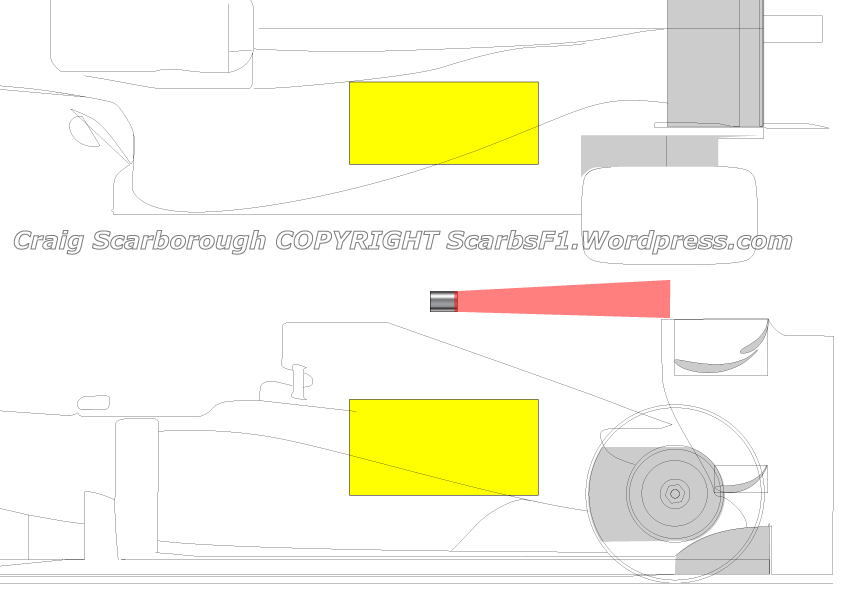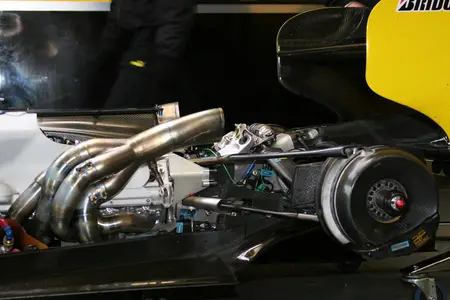Does anyone have any detail on next year's regulations, where the exhaust exits will be? I and wondering after this weekend, where hot blowing has effectively been legitimised, how are they going to make sure that teams don't just start hot blowing the rear wing for example, or some other bodywork part?
You are using an out of date browser. It may not display this or other websites correctly.
You should upgrade or use an alternative browser.
You should upgrade or use an alternative browser.
Technical 2012 regulations regarding exhaust positioning and blowing
- Thread starter jez101
- Start date
But the problem this weekend was how to ban blowing?It has already been confirmed that next year blowing is banned and the exhausts will be periscopic anyway.
Of course that could all change between now and next March.
Ok, they can presscribe where the outlets can and cannot be in new chassis regs, but what I am taking away from this weekend is that they are going to really struggle to define a ban on blowing.
Does anyone have any detail on next year's regulations, where the exhaust exits will be? I and wondering after this weekend, where hot blowing has effectively been legitimised, how are they going to make sure that teams don't just start hot blowing the rear wing for example, or some other bodywork part?
http://scarbsf1.wordpress.com/
Following the meeting of the Technical Working Group, the FIA have agreed to mandate periscope style exhausts from 2012. This has been in an effort to rid the sport of exhaust blown diffusers, a trend that has dominated aero development in 2010 & 2011. While initially it was the FIA’s intention to move exhausts to the rear of the diffuser, the teams preferred to route the exhaust out of the top of the sidepods “periscope” style. This solution is far more aero neutral and prevents teams developing new complex exhaust routing to gain what little aero advantage there is from the rear exit. Also it benefits the engine suppliers who don’t have to retune their engines for long secondary exhaust pipe lengths.
It will undoubtedly be less useful than this year (or they would already be doing it), but I still think teams will find ways to use exhaust gasses to stall (at speed) and engage (under braking) the rear wing next year. Now that they understand it better, and critically seem to be able to feed it out (hot or cold) regardless of throttle position, there must be something to gain?
It will undoubtedly be less useful than this year (or they would already be doing it), but I still think teams will find ways to use exhaust gasses to stall (at speed) and engage (under braking) the rear wing next year. Now that they understand it better, and critically seem to be able to feed it out (hot or cold) regardless of throttle position, there must be something to gain?
I agree with that.The "genie" is out of the bottle and the designers will still seek to utilise the exhaust gases.
Nice way of putting it.I agree with that.The "genie" is out of the bottle and the designers will still seek to utilise the exhaust gases.
Does anyone have any detail on next year's regulations, where the exhaust exits will be?
I am sure I heard they will be at the front now, can't remember where on when I heard that, think Brundle mentioned it in a race weekend a while back.
I am probably wrong as it sounds strange that, that would be the case
According to various reports, Williams are trying a 2012 spec exhaust a the Abu Dhabi young driver test. There are some pictures on F1Technical.
The exhausts seem to exit onto the rear third of the engine cover. They might be trying to use the shape of the engine cover to direct the airflow. The autosport photo shows the red strip on the cover near the exhaust exit which might be some kind of heat shielding. This line might also indicate the direction they want the airflow to go, which is basically onto the beam wing.
Does anyone know if the rules have been set on engine mapping, hot and cold off throttle blowing etc?
The exhausts seem to exit onto the rear third of the engine cover. They might be trying to use the shape of the engine cover to direct the airflow. The autosport photo shows the red strip on the cover near the exhaust exit which might be some kind of heat shielding. This line might also indicate the direction they want the airflow to go, which is basically onto the beam wing.
Does anyone know if the rules have been set on engine mapping, hot and cold off throttle blowing etc?
Yeah, echo that. Looks like Williams are steeling a march on the others. After the kind of season they've had, anything that would give them a leg up for next year is going to help. No team can survive the results that they've been putting in for long.
I reckon the trick to the 2012 regs will be using the exhaust to stall the rear wing at full throttle.
but give greater downforce at low speed with the engine on overrun - probably a difficult circle to square.
http://scarbsf1.wordpress.com/category/f1-2012/ (I probably should have guessed Scarbs would have something on this!)
Maybe not the easiest read, but some nice pictures showing where exits are allowed and some analysis of the various options. If I may briefly try and summarise, using his drawings (hope he doesn't mind hotlinks!)

Scarbs has a load more drawings on this, as well as an analysis of the elements that could be blown. He suggests a range of options which I will again summarise, but you should visit his site for the drawings.
It certainly seems that there are a lot of different avenues for the teams to explore...! No wonder Williams are getting started early. Comparing the pictures with Scarbs' drawings, it looks like the Williams position is about as close the the centreline and the rear of the car as they are allowed and is also seems they are close to maxing the angles (10 deg towards the centre and 30 deg up from the horizontal). Looking at their lap times, it certainly doesn't look like they are going to suffer greatly compared the the EBD, does it?
There is so much more innovation to come in this area over the winter, and what I like about it is how much more visible and obvious the exits now are and how much easier it will be to understand the effects. If I was betting, my money would be on a drag reduction system to supercharge the DRS, but I have no technical basis for that - ie. it's a wild guess
Maybe not the easiest read, but some nice pictures showing where exits are allowed and some analysis of the various options. If I may briefly try and summarise, using his drawings (hope he doesn't mind hotlinks!)

- The yellow boxes are where the exits can be. The last 100mm of pipe must be within this section.
- The last 100mm of pipe must also be round and be of 75mm internal diameter, with no obstructions (to stop people trying to manage the airflow)
- The angle of the exit is also defined:between 10 and 30 degrees from the horizontal axis (where the hour hand is on your watch between 2 o'clock and 2:40) and plus or minus 10 degrees from the car's centreline
- Crucially, there are also rules that say that you cannot blow onto any sprung element of the car between the exit and the rear axle line. This stops the idea I had to blow the engine cover or other bits for example and to use that to manage the airflow. This is looked at by drawing a cone from the exit extending 3 degrees outwards to the rear axle line. No sprung element can be in this cone.
- No other gasses can enter or exit the exhaust along any point in its length (which seems to address cold blowing)
Scarbs has a load more drawings on this, as well as an analysis of the elements that could be blown. He suggests a range of options which I will again summarise, but you should visit his site for the drawings.
- aero neutral - aim at the gap below the rear wing
- beam wing - unlikely he says
- suspension elements - these can be blown in front of the axle line as they are not sprung, but there are 5 degree limits the the angle of these components
- inner rear wing endplates - could create downforce but also a lot of drag
- rear wing underside - perhaps the most beneficial
- rear wing top - more downforce with less incremental drag
- outside rear wing endplates - may reduce drag while on throttle
- brake ducts - no sprung so again can be blown in front of axle, adding downforce directly onto the tyres
It certainly seems that there are a lot of different avenues for the teams to explore...! No wonder Williams are getting started early. Comparing the pictures with Scarbs' drawings, it looks like the Williams position is about as close the the centreline and the rear of the car as they are allowed and is also seems they are close to maxing the angles (10 deg towards the centre and 30 deg up from the horizontal). Looking at their lap times, it certainly doesn't look like they are going to suffer greatly compared the the EBD, does it?
There is so much more innovation to come in this area over the winter, and what I like about it is how much more visible and obvious the exits now are and how much easier it will be to understand the effects. If I was betting, my money would be on a drag reduction system to supercharge the DRS, but I have no technical basis for that - ie. it's a wild guess

Erm.Seen that before.
Sorry mate, I wasn't trying to duplicateErm.Seen that before.
 It's the same url, but it now has an updated piece (written October 26th your post linked to one from 17th June that is now the second one down in Scarbs' category for F1 2012).
It's the same url, but it now has an updated piece (written October 26th your post linked to one from 17th June that is now the second one down in Scarbs' category for F1 2012).Similar threads
- Replies
- 26
- Views
- 4K
- Replies
- 11
- Views
- 3K
- Replies
- 38
- Views
- 10K
- Replies
- 13
- Views
- 2K

